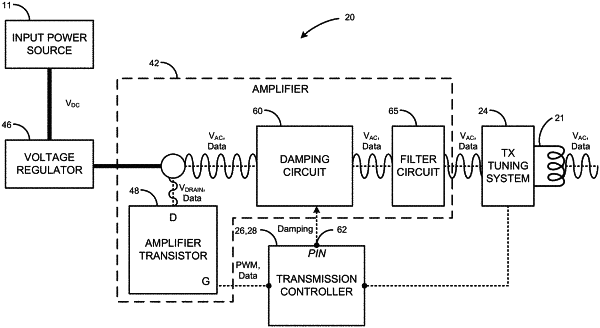| CPC H04B 5/0037 (2013.01) [H02J 50/12 (2016.02); H02J 50/20 (2016.02); H02J 50/80 (2016.02)] | 16 Claims |

|
1. A method for operating a wireless power transmission system, the method including:
providing, by a transmission controller of the wireless power transmission system, a driving signal for driving a transmission antenna of the wireless power transmission system, the driving signal based, at least, on an operating frequency for the wireless power transmission system;
receiving, by at least one transistor of an amplifier of the wireless power transmission system, the driving signal at a gate of the at least one transistor;
inverting, by the at least one transistor, a direct current (DC) input power signal to generate AC wireless signals at the operating frequency;
receiving, at a damping transistor of a damping circuit, a damping signal for switching the damping transistor to control signal damping during transmission or receipt of wireless data signals in-band of the AC wireless signals, wherein the wireless data signals are one of on-off-keyed (OOK) in-band data signals or amplitude-shift-keyed (ASK) in-band data signals;
determining, by the transmission controller, the damping signal, wherein the damping signal is in a “high” state when the wireless data signals are in a “low” state and the damping signal is in a “low” state when the wireless data signals are in a “high” state; and
selectively damping, by the damping circuit, the AC wireless signals, during transmission of the wireless data signals, based, at least in part, on the damping signal.
|